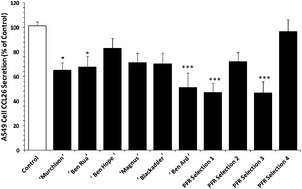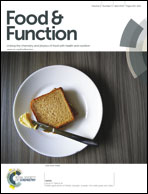Blackcurrant cultivar polyphenolic extracts suppress CCL26 secretion from alveolar epithelial cells
Abstract
Eosinophil recruitment to the airways is a characteristic feature of allergic asthma. Eotaxins are potent chemokines that regulate the recruitment of eosinophils to sites of inflammation. Of these, CCL26 is linked to persistent eosinophil recruitment in the later phase of an allergic response. We evaluated the effectiveness of 10 different blackcurrant cultivar polyphenolic extracts in suppressing CCL26 secretion in stimulated human alveolar epithelial cells. Correlation analysis to identify the potential blackcurrant composition constituent(s) involved in CCL26 suppression and the effects of the four major anthocyanins present in blackcurrants to validate results was conducted. All blackcurrant polyphenolic extracts suppressed CCL26 secretion by lung alveolar cells; however, differential efficacy was observed, which was attributed to their cultivar-specific polyphenolic composition profiles. We identified that the ratio of concentrations of delphinidin glycosides to cyanidin glycosides in the blackcurrant cultivars was an important determinant in influencing CCL26 suppression in lung cells. Our findings support the potential use of blackcurrants or blackcurrant-derived foods/ingredients in managing lung inflammation and the development of specific cultivars as functional foods/ingredients with beneficial biological activities.


 Please wait while we load your content...
Please wait while we load your content...